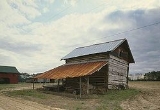
Smith Tobacco Barn
Encyclopedia
Smith Tobacco Barn is flue-cured tobacco barn
in Dillon County, South Carolina. It is on the east side of a dirt road, 0.25 mi (0.402335 km) south of South Carolina State Highway 17-34, 0.5 mi (0.80467 km) north of South Carolina State Highway 17-155, and about 1 mi (1.6 km) east of the intersection of South Carolina State Highway 17-22 and South Carolina State Highway 155. It was named to the National Register of Historic Places
on December 4, 1984.
and is flue-cured. The traditional barns had one or two fireboxes
using wood or coal. In the 1950s, many barns were changed to gas or oil heat for better temperature regulation.
Tobacco leaves were strung onto tobacco poles that were laid across horizontal tier poles in the barn. There were three drying stages. The first stage at 105 °F (41 °C) to 110 °F (43 °C) dried the leaves. In the second stage, the temperature was raised to 130 °F (54 °C) to 135 °F (57 °C) to yellow the leaves. The final stage was at 160 °F (71 °C) to 170 °F (77 °C) to dry the stems.
. There are small rectangular doors in the gables that can be opened for ventilation. On the south and east sides, there are metal shed roofs supported by posts. These sheds provided shade for stringing leaves. The east and west sides have small doors at ground level. The name "J. L. King" and the date "1942" are scratched into the chinking. The barn was divided into five "rooms" or "bents" by wooden tier poles.
On the south end, there is a brick, double-arched firebox that has been bricked in. As can be seen in other photographs, the fuel was later changed to gas.
At the time of its nomination, it was said to be no longer used as a tobacco barn, but was considered the most intact tobacco barn in Dillon and Marion counties built between 1895 and the 1950s. It was also described as an "extremely fragile resource."
Tobacco barn
The tobacco barn, a type of functionally classified barn found in the United States, was once an essential ingredient in the process of air-curing tobacco. In the 21st century they are fast disappearing from the American landscape in places where they were once ubiquitous. The barns have declined...
in Dillon County, South Carolina. It is on the east side of a dirt road, 0.25 mi (0.402335 km) south of South Carolina State Highway 17-34, 0.5 mi (0.80467 km) north of South Carolina State Highway 17-155, and about 1 mi (1.6 km) east of the intersection of South Carolina State Highway 17-22 and South Carolina State Highway 155. It was named to the National Register of Historic Places
National Register of Historic Places
The National Register of Historic Places is the United States government's official list of districts, sites, buildings, structures, and objects deemed worthy of preservation...
on December 4, 1984.
History
Bright tobacco was introduced in South Carolina in the 1880s and 1890s. This grows well in sandy, loamy soils of the Pee DeePee Dee
The Pee Dee region of South Carolina is the northeastern corner of the state. It is the area of the lower watershed of the Pee Dee River, named after the Pee Dee Native American tribe. Its center is Florence...
and is flue-cured. The traditional barns had one or two fireboxes
Firebox (architecture)
A firebox or firepit is the part of the fireplace where fuel is combusted, in distinction to the hearth, chimney, mantel, overdoor and flue elements of the total fireplace system. The firebox normally sits on a masonry base at the floor level of the room...
using wood or coal. In the 1950s, many barns were changed to gas or oil heat for better temperature regulation.
Tobacco leaves were strung onto tobacco poles that were laid across horizontal tier poles in the barn. There were three drying stages. The first stage at 105 °F (41 °C) to 110 °F (43 °C) dried the leaves. In the second stage, the temperature was raised to 130 °F (54 °C) to 135 °F (57 °C) to yellow the leaves. The final stage was at 160 °F (71 °C) to 170 °F (77 °C) to dry the stems.
Description
The barn is rectangular with a metal gable roof and a brick foundation. The walls up to the eaves are sawn timber. The timbers are notched at the corners and have mortar chinking. The gables ends are covered with horizontal weatherboardingWeatherboarding
Weatherboarding is the cladding or ‘siding’ of a house consisting of long thin timber boards that overlap one another, either vertically or horizontally on the outside of the wall. They are usually of rectangular section with parallel sides...
. There are small rectangular doors in the gables that can be opened for ventilation. On the south and east sides, there are metal shed roofs supported by posts. These sheds provided shade for stringing leaves. The east and west sides have small doors at ground level. The name "J. L. King" and the date "1942" are scratched into the chinking. The barn was divided into five "rooms" or "bents" by wooden tier poles.
On the south end, there is a brick, double-arched firebox that has been bricked in. As can be seen in other photographs, the fuel was later changed to gas.
At the time of its nomination, it was said to be no longer used as a tobacco barn, but was considered the most intact tobacco barn in Dillon and Marion counties built between 1895 and the 1950s. It was also described as an "extremely fragile resource."

